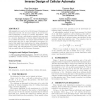Free Online Productivity Tools
i2Speak
i2Symbol
i2OCR
iTex2Img
iWeb2Print
iWeb2Shot
i2Type
iPdf2Split
iPdf2Merge
i2Bopomofo
i2Arabic
i2Style
i2Image
i2PDF
iLatex2Rtf
Sci2ools
GECCO
2008
Springer
2008
Springer
Self-adaptive mutation rates in genetic algorithm for inverse design of cellular automata
Self-adaptation is used a lot in Evolutionary Strategies and with great success, yet for some reason it is not the mutation adaptation of choice for Genetic Algorithms. This poster describes how a self-adaptive mutation rate was used in a Genetic Algorithms to inverse design behavioral rules for a Cellular Automata. The unique characteristics of this search space gave rise to some interesting convergence behavior that might have implications for using self-adaptive mutation rates in other Genetic Algorithm applications and might clarify why self-adaptation in Genetic Algorithms is less successful than in Evolutionary Strategies. Categories and Subject Descriptors I.2.8 [Computing Methodologies]: ARTIFICIAL INTELLIGENCE—Problem Solving, Control Methods, and Search General Terms Algorithms, Experimentation, Theory Keywords Self Adaptation, Genetic Algorithms, Cellular Automata
Evolutionary Strategies | GECCO 2008 | Genetic Algorithms | Optimization | Self-adaptive Mutation Rates |
| Added | 09 Nov 2010 |
| Updated | 09 Nov 2010 |
| Type | Conference |
| Year | 2008 |
| Where | GECCO |
| Authors | Ron Breukelaar, Thomas Bäck |
Comments (0)

